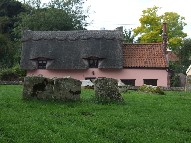| |
|
| |
|
 |
|
Wattisfield is a
pretty village, although perhaps a little
spoilt by the busy A143, which runs
through just to the north of this church.
The name of the village suggests a place
where clay has been dug, and there is
still a pottery in the village today. St Margaret is set in a
lovely triangle, surrounded by fine
half-timbered houses. A gorgeous
ivy-covered Victorian former Rectory sits
just to the south east. The churchyard is
raised up above the road, suggesting that
the highway has cut down over the
centuries, and that this is an ancient
place. Reflecting this, the tower is a
bald example from the 13th century, but
it has had narrow Perpendicular windows
set into it. And, although much of the
tracery in the church windows has been
renewed, their shape dates them from this
same late medieval time. The open north
side of the churchyard is neat, with lots
of interesting headstones. A path leads
up to the simple north porch, an unusual
wooden survival from the eve of the
Reformation.
|
The north side of the
church, which faces the village street, is
perhaps a little stark, and is more impressive
than beautiful. But if you wander around to the
south side of the church, you find that here, in
complete contrast, there is an elegant and ornate
south porch. It is a 15th century festival of
knapped flint and red brick, with Marian
monograms, an angled sun-dial, and a terracotta
shield denoting the de la Pole family, who had it
built. It speaks of something beyond the
functional, beyond the merely necessary; ironic,
as it is no longer in use. The graveyard this
side is a riot of overgrown tombs, an absolute
delight.
| Mortlock and
Cautley found little to say about the
interior of St Margaret, which is almost
entirely of the 19th Century in
character. The high-pointed chancel arch
lends a sense of elegance, and everything
is neatly kept and obviously well-loved
and used. The 17th Century font cover has
eagle heads, which give it carachter, and
the late medieval font beneath it has
blank shields which were probably painted
once. The Victorians reused some of the
woodwork from the old screen in the
prayer desk. But
even if there are no significant
historical features, I still love to soak
up the feeling of a place where, in Eliot’s
words, prayer has been made valid. Here,
over the centuries, this community has
worshipped God in different ways; but it
was always the same community, always the
same God. I love stepping into that sense
of continuity.
|
|
 |
|
|
|
Simon Knott, December 2008
Amazon commission helps cover the running costs of this
site.
|
|
|

